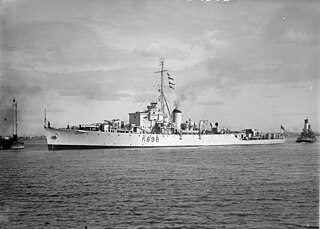Related Research Articles

Five ships of the Royal Australian Navy have been named HMAS Sydney, after Sydney, the capital city of New South Wales.
Three ships of the Royal Australian Navy have been named HMAS Anzac, after the Australian and New Zealand Army Corps (ANZAC).
Two ships of the Royal Australian Navy have borne the name HMAS Arunta, a name derived from the Arrernte Aboriginals of central Australia.
HMT Ballarat, built for P&O in 1911 to expand its Blue Anchor Line subsidiary. Requisitioned as a troopship in the First World War. On 25 April 1917 a German submarine torpedoed her in the English Channel. All her passengers and crew were rescued and she was taken in tow, but she sank the next day.

HMAS Burdekin (K376) was a River-class frigate that served the Royal Australian Navy (RAN) from 1944 to 1946. She was named for the Burdekin River in Queensland and was one of twelve River-class frigates built for the RAN during World War II.

HMAS Condamine (K698/F698), named for the Condamine River in Queensland, was a River-class frigate of the Royal Australian Navy (RAN). Commissioned in 1946, Condamine served in the Korean War. The ship was paid off in 1955, and sold for scrap in 1961.
Two ships of the Royal Australian Navy have been named HMAS Gascoyne, after the Gascoyne River, the longest river in Western Australia.
Two ships of the Royal Australian Navy (RAN) have been named HMAS Hawkesbury, after the Hawkesbury River in New South Wales.

HMAS Murchison (K442/F442) was a Modified River or Bay-class frigate of the Royal Australian Navy (RAN). The ship was laid down in 1943, but not commissioned until after the end of World War II. Murchison fought in the Korean War, was decommissioned in 1956, and sold for scrap in 1961.
Two ships of the Royal Australian Navy (RAN) have been named HMAS Norman. The second ship is named for the Norman River in Queensland.
Four ships of the Royal Australian Navy been named HMAS Parramatta, for the Parramatta River. The name comes from the Barramattagal people.
Three ships of the Royal Australian Navy (RAN) have been named HMAS Stuart:
Two ships and a shore establishment of the Royal Australian Navy (RAN) have been named HMAS Torrens, after the River Torrens.
Two ships of the Royal Australian Navy have been named HMAS Warramunga, after the Warumungu Aborigines.
Two ships of the Royal Australian Navy have been named HMAS Warrego, for the Warrego River in Queensland.
Two ships of the Royal Australian Navy have been named HMAS Toowoomba, after the city of Toowoomba, Queensland.
Three ships of the Royal Australian Navy have been named HMAS Adelaide, after Adelaide, the capital city of South Australia:

HMAS Diamantina (K377/F377/A266/GOR266), named after the Diamantina River in Queensland, is a River-class frigate that served the Royal Australian Navy (RAN). Constructed in the mid-1940s, Diamantina was active from 1945 until 1946, was placed in reserve, then was recommissioned as a survey ship from 1959 until 1980.
Four Australian naval vessels have been named HMAS Paluma after an Aboriginal word meaning "thunder":
Two ships of the Royal Australian Navy (RAN) have been named HMAS Maryborough, after the city of Maryborough, Queensland
References
- ↑ "Navy Marks 109th Birthday With Historic Changes To Battle Honours". Royal Australian Navy. 1 March 2010. Archived from the original on 13 June 2011. Retrieved 23 December 2012.
- ↑ "Royal Australian Navy Ship/Unit Battle Honours" (PDF). Royal Australian Navy. 1 March 2010. Archived from the original (PDF) on 14 June 2011. Retrieved 23 December 2012.